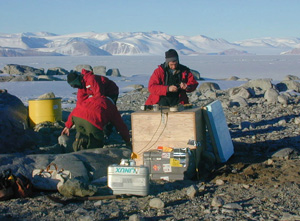Douglas A. Wiens, Ph.D., professor and chair of earth and planetary sciences in Arts & Sciences, will head the seismology research team of an ambitious international effort to map and analyze an unknown part of Antarctica.
The project is called Antarctica’s Gamburtsev Province (AGAP) after the Gamburtsev Subglacial Mountains, which are the main feature of the region.

Wiens, teamed with Patrick Shore, computer specialist in earth and planetary sciences, and graduate students David Heizel and Amanda Lough, will install 26 seismographs on the frozen surface of central Antarctica. This part of the world is a geological mystery because mountains there are covered with ice one to two miles deep, so there aren’t any rock samples to analyze. As part of the celebration of International Polar Year (IPY), this international effort will map what lurks beneath the ice using radar and seismic imaging. Last year, Wiens and a small group of Washington University researchers installed 10 seismographs in the same general region.
The National Science Foundation is funding Wiens and other American researchers, including Robin Bell, Ph.D., of the Lamont Doherty Earth Observatory of Columbia University, who heads the radar mapping efforts, and investigators from Pennsylvania State University and University of Kansas. Researchers from Great Britain, Australia, Germany, Japan and China also will contribute to the study. Wiens and his group will be in Antarctica from early December until January 10.
The combined projects under the AGAP partnership are multinational and multidisciplinary and include aerogeophysics, traverse programs, passive seismic experiments and ice core and bedrock drilling. The surveys are targeted at understanding the origin of these enigmatic mountains to provide crucial new inputs into ice sheet and climate models.
The international team will address four fundamental questions: 1) What role does high topography play in the formation of continental ice sheets? 2) How are major highlands formed in the middle of continents, far away from the plate boundaries that cause most mountain belts? 3) How do geologic processes control the formation of newly discovered lakes beneath the ice sheet? 4) Where is the oldest ice, and thus the oldest climate record in the Antarctic ice sheet?
“There is more known about Mars than this part of our Earth,” said Wiens. “The formation of the mountain ranges is particularly intriguing. Some process in the Earth must have caused these mountains to rise. The mountains were then the locus of the first continental ice sheet when the earth started to cool 30 million years ago.
“Planes with skis instead of wheels will use radar to see through the ice and map the topography of the mountains. Right now we do not even know how high the mountains really are. Seismic waves from earthquakes around the world will allow us to see below the ice into the crust and the mantle. Because we can’t find rock samples, we have to use seismic waves and radar.”
Wiens’ group will be approximately 300 miles from the South Pole in a newly constructed camp called AGAP South.
Unlike the Arctic, where several nations including Russia are vying to control shipping and mineral rights, the Antarctic is not currently a contentious part of the world.
“The Antarctic shouldn’t be a contested region as long as the Antarctic Treaty keeps getting renewed,” Wiens said. “There are claims to various parts of Antarctica, but the United States has none and doesn’t recognize ones that are out there. The Treaty was signed in 1961, which stated that it should be free and open for scientific research. It’s ironic that a treaty signed at the peak of the Cold War has been the basis for peace in this part of the world for decades.”
Wiens and his colleagues will return at the end of 2009 to pick up the seismographs and begin analyzing data, which will continue through 2011. They hope to leave a few of the seismographs in Antarctica to form the basis of a permanent environmental observation network.